

early Bronze Age Aegean and Mediterranean civilizations (pre-Greeks and pre-Romans) were poorly known archaeologically until relatively recently
possible explanations for origins of complex society include these factors:
trade
control of agricultural surplus
control of raw materials
religious power
and sanctions
systems approach (combination of factors)
INTRODUCTION
studied extensively by Arthur Evans between 1900-1935; he spent over one million dollars on excavation and restoration of Knossos site itself
named by Evans for mythical King Minos of Crete
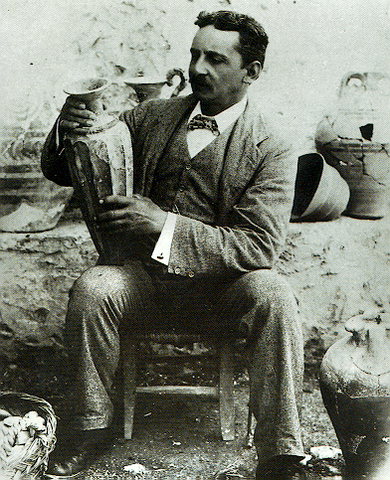
LOCATION
mountainous island of Crete southeast of Greek mainland
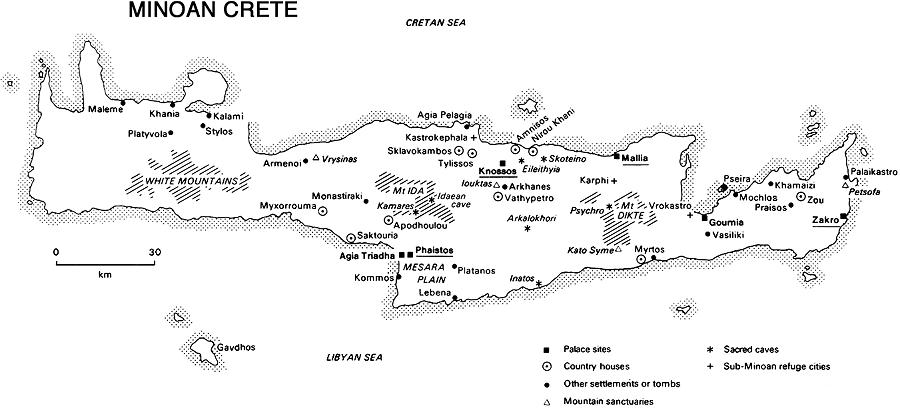
ORIGINS
probably came from Asia Minor beginning 7000 BC but were several waves
spoke IndoEuropean language
used to think they were Egyptians, lost tribes, ancestors of Phoenicians or ancestors of Greeks
reason for increased complexity: systems theory involving
grape,
olive and metals
SUBSISTENCE
farmers and herders, domesticated olive very important
also used marine resources
SETTLEMENT / ARCHITECTURE
seven major power centers on Crete (palace complexes), all located
in
the eastern part of the island: Knossos (largest), Mallia, Gournia,
Kato
Zakro, Myrtos, Hagia Triadha, Phaistos (see map above)
palaces unfortified
stone construction common
numerous towns and estates
country mansions are new site type in Second Palace period
round columns with wide top and tapered base common; pillars may have been worshipped
U-shaped horns were common motif in architecture
Horn motif at Knossos, Crete.
UNIQUE TRAITS
plumbing and water controlmany methods of water control, especially at palacesdouble axe symbolangled drainage system of stone gutters to channel and torrential rain runoff to cisterns
system of ducts, terra cotta gutters and catch basins fed into huge underground channels of stone and cement to remove waste materials, accessed by manhole
toilets (seats over drains flushed by pouring water in)
bathrooms with terra cotta tubs not linked to sewer system
Sewer system and queen's bathroom at Knossos, Crete.
example of institutionalized state symbolcommon in decorations at palaces
example of panther in double axe form in text
used as weapons and tools, but smaller stylized ones (often of gold) probably used in ritual context to kill sacrificial animals and used in cult activities or Minoan religion in general
carved all over the palace walls
Minoan word for it was "labrys" and word "labyrinth" means house of the double axe
Shrine of Double Axes at Knossos is good example
SITES
Knossos
largest palace complexMallia used from 2000-1450 BC, northeastern coastover 6 acres and 40,000 to 80,000 people at palace and surrounding town in heyday about 1700 BC
built on mound and located on northern coast of island
destroyed twice (1700 BC by earthquake and 1450 BC for unknown reason)
Aerial view of Knossos, Crete.
Phaistos second largest, southern coast, destroyed twice by earthquakes
Kato Zakro east coast, important naval base
Hagia Triadha near Phaistos, L-shaped site, may've been summer residence of ruler at Phaistos
Gournia on northeastern coast
Myrtos on southeastern coast
SOCIAL ORGANIZATION
highly stratified but may not have been clear middle class
many levels within upper and lower classes
females appear to have had considerable freedom and prominent
position
in religion
POLITICAL ORGANIZATION
little is known
ruler may've been king, queen, priest-king, priestess-queen, god-king, priest
highly institutionalized bureaucracy but composition unknown
naval power in Aegean
RELIGION
preoccupied with religion, polytheistic
many representations of religious activities in seals, murals, rings and statues
no public temples or large centers of worship, but find shrines (small rooms with altars) at palaces and villas and small niches or alcoves in homes of commoners
some ceremonies like dancing and tree shaking took place outside on mountain tops at stone sanctuaries or in caves
chief deities were goddesses associated with natural world, main is Mistress of Animals
other deities Snake Goddess, Eileithyia Goddess of Childbirth, Dove
Goddess, Poseidon, Hermes
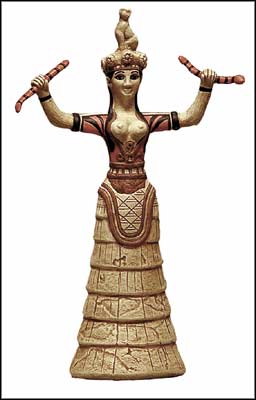
Snake goddess recovered from Knossos.
sacred animals were snake (guardian of house), dove and bull
goddesses associated with snakes and doves but significance unknown
goddess depictions mostly found in palace shrines
major religious symbols are double headed axe and horns of
consecration
ECONOMICS / TRADE
primary exports were pottery, olive, wine
merchant class important
sea trade widespread
DECLINE
occurred in Second Palace period
gradual decline after second palace collapse in 1450 BC
reason may've been natural catastrophe (eruption of Thera to north), foreign invasion, domestic upheaval
lots of evidence of massive fires but not all palaces destroyed at once
palaces never rebuilt
information comes primarily from archaeology, early historians, and folklore
represents last phase of Helladic culture on the Greek peninsula
LOCATION
Greek peninsula, Peloponnesus area
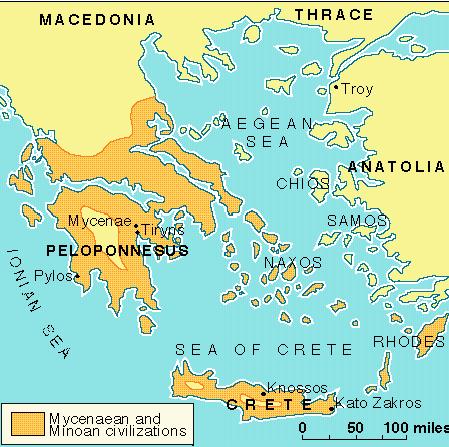
ORIGINS
wealth related to wine, olive and metals
rise related to military force and external contacts of wealthy lords or barons who entered the peninsula
two interpretations of origins:
indigenous, based on widespread farming and herding cultures already established there
SUBSISTENCE
farmers and herders, probably imported a lot of food
also used marine resources
SETTLEMENT
palace complexes surrounded by town and village satellites
some palaces fortified with wall and towers, some not
little evidence of early settlements
palaces and stone tombs are conspicuous sites
most settlements unwalled, various plans but often follow terrain,
multiroom
houses
UNIQUE TRAITS
megaron
large columnated central hall of the royal palaces of Mycenaen kingscyclopean architecture
throne on one side reached through antechamber and porch
central hall of palace where state business was conducted
walls covered with frescos
elaborately decorated furniture
floor decorated with bright effigy and geometric designs
circular hearth 10-15' in diameter at center of room
one entrance flanked by vestibules
Megaron at Pylos, Greece.
massive walls and steps constructed of immense irregular roughly cut blocks of stoneerected after 1250 BC
mostly defensive purposes
Cyclopean fortification (with Lion Gate) at Mycenae, Greece.
SITES
Mycenae
destroyed and reoccupied several timesPyloscenter of ivory working, pottery manufacture and bronze weapon production
most important city by 1300 BC
overlooked fertile Agros plain
two grave circles of shaft graves (6 and 14 shafts) for two royal dynasties maybe
Treasury of Atreus here
citadel palace with fortification wall, in some places 50' thick
King Agamemnon
Aerial view of Mycenae, Greece.
destroyed and burned 1200 BC (pirate raid?) and not reoccupiedother palace complexesKing Nestor
megaron with giant octopus
palace virtually unfortified
surrounded by network of smaller towns and villages who helped support palace inhabitants
specialized in pottery
many specialists worked at palace
careful records of taxes, payroll, craft production, etc on tablets
Ithaca (famed home of Odysseus)Sparta
Tiryns (in Peloponnesus and sacked after 1200 BC)
Thebes
Gla (north of Thebes, sacked by ?)
Iolkos (in Thessaly, sacked 1200-1150 BC)
SOCIAL ORGANIZATION
major classes were nobles, military, merchants, peasants
power and wealth of nobility gained through force, use of metal weapons, methods of fighting, trade contacts and foreign contacts
nobles may've been related
not much known about commoners
POLITICAL ORGANIZATION
began as collection of small independent kingdoms ruled by king or prince
later smaller kingdoms were absorbed by major ones of Mycenae, Tiryns, Thebes and Pylos
big ones called "palace-states"
palace was center of administrative-military-industrial system
gained control of Aegean from Minoans about 1500 BC, occupying Knossos but not the other palaces on Crete
established trading colonies and contacts throughout Mediterranean Sea including Levant
expanding wealth and power from 1600-1250 BC
developed a navy
warriors used unique figure-8 shaped shields that hung to feet (see picture in text)
spear, and boars'-tusk helmet, some use of armor (see pictures in text)
chariots were used in warfare
RELIGION
polytheistic, preGreek gods and goddesses
Zeus, Hera, Athena, Poseidon, etc.
cult activities based in multiroom shrines
snake important as in Crete; seen as benevolent protector of the
home
TRADE / ECONOMICS
established trading colonies and contacts throughout Mediterranean Sea including Levant
merchant class
sea trade widespread
importance of wine, olives, metals
DECLINE
palace destruction begins about 1200 BC
not sacked by invading Dorians as previously thought; maybe the Sea Peoples
decline related to inability to produce enough food on mainland (had to import a lot of grain), interference of trade due to piracy, civil unrest or stasis ("internal interstate wars"), destruction of palace complexes by unknown people
collapse was fairly rapid as culture disappeared by about 1100 BC
replaced by feudal system, the "dark ages" of Greece
called themselves "Rasenna" "Rasna" or "Etruria"
"Italy's first great civilization"
most of our info about them comes from Etruscan grave goods and
frescos
plus written records of other cultures
LOCATION
north-central Italy
most sites in an area bounded by Arno River to north, Tiber River to south and east, and Tyrrhenian Sea to west (15,000 sq mi)
some settlements to Po River in north, and Apennine Mtns to east
southernmost extent was to location of Greek trading colonies
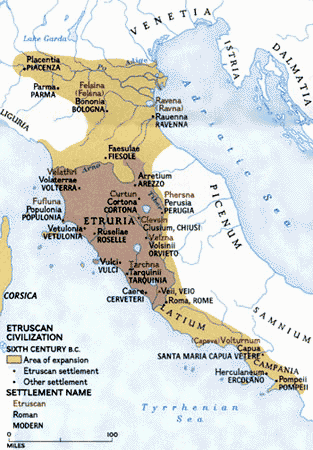
ORIGINS
two interpretations
migration of people from Lydia, Turkey about 1300 BC
SUBSISTENCE
farming and herding
specialized in pigs but also raised cattle, sheep, goats, chickens, geese, chickens
raised cereals (barley, wheat, millet), fruit trees, vegetables, grape, but no olives
imported olive oil
cheese and wine
SETTLEMENT
some large cities (most now buried or destroyed)
upper class homes of wood and/or mud-brick and styles mimicked by
burial
tombs
UNIQUE TRAITS
bucchero
distinctive black pottery with metallic sheenfasces emblemcommon forms are bowls, vases and plates
color derived from use of locally available, iron-rich clay fired in oxygen atmosphere
decorative motifs include writing, animals (dog, horse), Eastern designs
important manufacturing center at Caere
standardized artwork of stateengineering (hydraulic and civil)bundle of rods bound around a central, double-bladed axe
symbolized kings sovereignty and rulers power to order punishments
carried by kings' attendants on ceremonial occasions
often made of iron
first city to use it as a power symbol was Vetulonia
first fasces found at Vetulonia in 1890s
used by Romans (single-bladed) and Mussolini
water control devices used to control flooding and erosion on fields and roadsdivinationcut underground passages (cuniculi) to channel surface water away from fields and roads
cuniculi 5-6' high, 1.5' wide with shafts to surface every 100'
over 28 miles of cuniculi have been found
terra cotta pipes used to carry water to homes from cisterns and stone-lined drains used to remove excess water
sewage systems in some towns
Subterranean cuniculi.
foretelling the future, determining the wishes of the gods, and discovering the meanings behind eventspowerful priestly class of soothsayers drawn from the aristocracy
read omens based on patterns in lightning and thunder and based on bumps on the internal organs of animals
used animal liver extensively and believed it reflected the organization of the universe (16 parts with related gods)
Sheep liver regions used in divination.
direction of origin of lightning was used to read omens
identified 11 directions, each associated with a god
brontoscopic calendar for relating lightning and thunder with dates for future events, ex: bolt on July 14 means power will change hands
SITES
Caere
bucchero manufacturing siteRomeBanditaccia necropolis
craft and trade center
economic leader in north-central Italy
mines brought prosperity after 650 BC
after 650 BC primary Etruscan city
Dromos at Caere, Italy.
founded 753 BCFuflunafirst Etruscan ruler Lucius Tarquinius, became king in 616 BC and established Tarquin Dynasty
control passed to Latins and Greeks in 506 BC
center of iron industry, coin mintingTarquiniiby 400 BC was similar to present-day Pittsburgh
produced 10-12,000 tons of ore per year for 400 years based on slag heaps
two zones in city (industrial sector near sea with port and navy and upper city with residences)
north of RomeVeii artistic center in early 500s, school of terra cotta sculpture with master sculptor Vulca in residencebronze exports
650-700 BC richest and most influential city
Vulci major art center in late 500s, bronze and stone sculpture
Elba island with vast iron deposits
and
many mines
SOCIAL ORGANIZATION
occupational specialization (sailors, cobblers, merchants, warriors, miners, servants, slaves, aristocrats)
very lavish lifestyle of aristocracy but little is known about commoners, big gap between the two
may have been a special class "etera" of special servants to lords with some privileges like managing farms
no "middle" class
slaves and servants treated well
women had lots of freedoms to participate in various activities, to
own property, to retain own names compared to Greeks and Romans
POLITICAL ORGANIZATION
no centralized power
many city-states
powerful navy
height of power about 600 BC
adopted military techniques from Greeks (ie. infantry, phalanx)
use of sturdy leather boots in battle was unique
RELIGION
strongly influenced by Greek pantheon
chief deity was Tinia (=Zeus), also borrowed Apollo and Artemis but changed names, Greek Hera = Etruscan Uni and Greek Minerva = Etruscan Menrva
local gods and supernaturals also
called the most god-fearing culture of the time
intensive belief that humans are powerless and here to obey gods' wishes
all events preordained (hence divination was important)
priestly class of soothsayers (haruspices read entrials and fulguriatures read lightning and thunder)
universe divided into 16 parts each with chief deity
death and underworld had 5 gods + Tinia, celestial realm had 4 gods + Tinia, and nature and earth had 6 gods (15 total for 16 sectors)
foci of worship was temples of wood, mud-brick and terra cotta on stone foundations facing south
Linen Book is only sacred text surviving (on mummy wrappings)
TRADE / ECONOMICS
imported olive oil, gold, ivory, amber, Greek vases;
exported metal ores of copper, lead and iron, finished metalworks, produce
traded with Greece and its colonies, Mediterranean islands,
Phoenicians,
Carthage
DECLINE
gradual takeover by Romans beginning 4th century BC coupled with drop in trade, class conflicts, and invasions from north
absorbed by Roman empire
REFERENCES
Price and Feinman (2001), Feder (2000), Fagan (2002), Warren (1989), Hamblin (1974), Edey (1974)